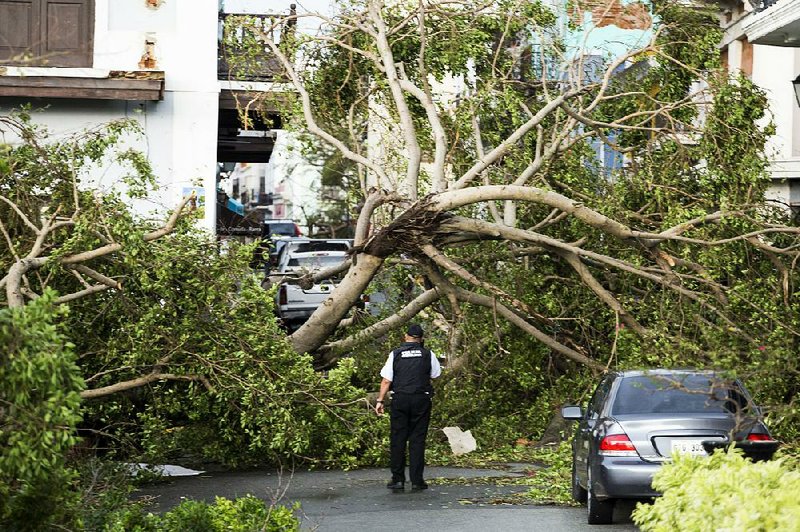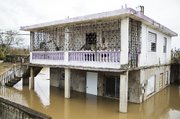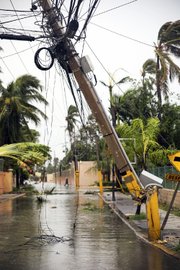Puerto Ricans got their first clear view Thursday of the devastation wrought by Hurricane Maria -- splintered homes, crumbled balconies, uprooted trees and floodwaters coursing through streets.
The storm cut a path through the island Wednesday, and 100 percent of the territory, home to about 3.4 million people, remained without power. Officials predicted that it could take months to restore electricity as rescue brigades ventured out to assess the toll of death and injury.
Flash-flood warnings persisted, according to the National Hurricane Center, with "catastrophic" flooding "especially in areas of mountainous terrain." Anxious relatives in the mainland U.S. and elsewhere took to social media in an effort to find news of their loved ones.
Puerto Rico faces numerous obstacles as it begins to emerge from the storm: the weight of an extended debt and bankruptcy crisis; a recovery process begun after Irma, which left nearly 70 percent of households without power; the difficulty of getting to an island far from the mainland; and the strain on relief efforts by the Federal Emergency Management Agency and other groups spread thin after several recent storms.
Click here for larger versions
Photos by The Associated Press
Photos by The Associated Press
"Irma gave us a break, but Maria destroyed us," said Edwin Serrano, a construction worker in Old San Juan.
Forecasters said Puerto Rico would see about 2 feet of rain by today, with as much as 35 inches in places. Storm surges were expected to raise water levels as much as 6 feet in the Dominican Republic.
The storm was forecast to approach the Turks and Caicos Islands and the Bahamas overnight. There is significant concern about the expected "life-threatening" storm surge of 9 to 12 feet on those islands, according to Michael Brennan of the National Hurricane Center.
Then, the storm is forecast to veer into the open Atlantic, at no threat to the U.S. mainland.
[HURRICANE TRACKER: Follow Maria’s projected path]
Maria's death toll across the Caribbean, meanwhile, climbed to at least 19, nearly all of them on the hard-hit island of Dominica. In Puerto Rico, the government said at least two were killed but media outlets on the island were reporting additional deaths and the actual toll appeared unlikely to be known for days.
Puerto Rico Gov. Ricardo Rossello told CNN late Wednesday that officials knew of only one fatality in Puerto Rico.
The U.S. Coast Guard reported the death of a man aboard a capsized vessel near Vieques, Puerto Rico. A woman and two children were rescued from the boat by a British navy helicopter crew, it added.
President Donald Trump said Thursday that he would visit Puerto Rico, but gave no details on the timing of the trip.
In the U.S. Virgin Islands, Gov. Kenneth Mapp announced a 24-hour curfew for four islands until further notice. In Puerto Rico, Rossello had previously set a 6 p.m. to 6 a.m. curfew effective until Saturday.
POWER GRID IN RUINS
Puerto Rico appeared to have been "devastated," with power lines lying on the ground and rivers flowing over bridges, Jenniffer Gonzalez-Colon, Puerto Rico's nonvoting member of the House of Representatives, said Thursday on CNN.
Gonzalez-Colon, who spent much of the hurricane in a closet, said restoring power was crucial but added that the governor had estimated that it could take a month or more to get electricity back for the whole island. She suggested that without electricity, many of the pumps that supplied residents with running water would not be functioning.
Complicating matters, more than 95 percent of the island's wireless cell sites were out of service, said Ajit Pai, chairman of the Federal Communications Commission.
Ricardo Ramos, chief executive of the government-owned Puerto Rico Electric Power Authority, told CNN Thursday that the island's power infrastructure had been basically "destroyed."
"You cannot live here without power," said Hector Llanos, a 78-year-old retired New York police officer who planned to leave Saturday for the U.S. mainland to live there temporarily.
Like many Puerto Ricans, Llanos does not have a generator or gas stove.
"The only thing I have is a flashlight," he said, shaking his head. "This is never going to return to normal."
The grid was in sorry shape long before Maria -- and Hurricane Irma two weeks ago -- struck.
The territory's $73 billion debt crisis has left agencies like the state power company broke. It abandoned most basic maintenance in recent years, leaving the island subject to regular blackouts.
"We knew this was going to happen given the vulnerable infrastructure," Rossello said.
In San Juan, residents and business owners in the Condado area began to trickle into the streets Thursday to assess the havoc. Joggers ran past what resembled a beachside battlefield. Bikers pedaled slowly, taking in the overwhelming damage.
Condado, the tourist district of the island that has seen a reawakening of sorts with the opening of new hotels and restaurant chains over the past couple of years, was ravaged. Windows were blown out in the apartment buildings and hotels that line the promenade. A restaurant lost its roof. Parque del Indio, a popular seaside park for skaters and joggers, was blanketed with sand and water.
In Old San Juan, which like most of the island was without reliable cell service, people were thirsty for information. At Plaza de Armas, residents sat on benches and stoops to share what information they had. Those with radios were tuning into the only station broadcasting in the entire island.
Cristina Cardalda, 55, had just gotten her first phone call since Maria hit -- it was her cousin in Florida checking in. "I haven't heard anything from anyone," she said.
For Puerto Ricans living on the U.S. mainland, the news coming from the island has been magnified by the fact that many of them have been unable to get in touch with friends and relatives, given the sharp blow that Hurricane Maria dealt to the island's communications infrastructure.
"We're all anxious, we're all desperately seeking information and we're all on call to help Puerto Rico and give it whatever it needs," said David Galarza Santa, 48, a resident of the Brooklyn borough of New York City who said he has been unable to reach his family in the municipality of Florida, west of San Juan, since noon Wednesday.
But Galarza was optimistic that his family there, including his father and two older sisters, were doing well, in part because they had all hunkered down at his father's sturdy cement house. He also noted that Puerto Ricans were old hands when it came to surviving devastating storms.
More than 5 million Puerto Ricans live on the mainland, more than the population of the island itself, and the worry and stress were widely shared Thursday among those watching from afar. It was a feeling of "impotence," said Eliezer Velez, 44, of Atlanta.
Velez, who works for the Atlanta-based Latin American Association, said he was hoping to get in touch with his mother, two brothers and a number of uncles and cousins. He said a sister who lives on the island was able to send him a message through WhatsApp on Thursday morning; she relayed that everyone was OK.
"We're praying for them and hoping for the best," Velez said. "It's really sad that you're here, but your mind and your heart are on the island. We are here, but we belong there. I cannot describe the frustration that I'm not there."
AID ON THE WAY
Trump has declared Puerto Rico a disaster area, and said he was consulting with Rossello and federal officials about the recovery effort.
"We are going to start it with great gusto," he said. "But it's in very, very, very perilous shape. Very sad what happened to Puerto Rico."
"Puerto Rico was absolutely obliterated," Trump said during a meeting with President Petro Poroshenko of Ukraine at the U.N. in New York on Thursday.
"Their electrical grid is destroyed," Trump added. "It wasn't in good shape to start off with. But their electrical grid is totally destroyed. And so many other things."
The Federal Emergency Management Agency said it would open an air bridge from the mainland today, with three to four military planes flying to the island every day carrying water, food, generators and temporary shelters.
Despite the challenges his island faces, Rossello said on Twitter that "we will come out of this stronger than ever."
In an interview with WAPA radio Thursday, Rossello said reopening the island's ports was a priority as that would allow for shipments of aid, including generators, food, cots and medical supplies.
The White House also has declared the U.S. Virgin Islands a disaster area, to make federal funding available for residents of St. Croix.
On the damage in the Virgin Islands, Trump said, "All you have to do is take a look at a picture. They are flattened. Areas around there have been flattened."
Prime Minister Roosevelt Skerrit called the damage from the storm "unprecedented" in a Thursday interview with a television station on the nearby island of Antigua. He gave a death toll of 15 but warned that the number may rise, as at least 20 people were still missing and dozens of villages had yet to be assessed.
"We have many deaths but it is just a miracle that we do not have hundreds of deaths in the country," Skerrit said. "Because when you look at the destruction, people were in those homes."
The storm made landfall there Monday, bringing with it winds of up to 155 mph. Aerial views of the island showed houses and businesses torn apart by the storm.
Skerrit planned to travel to New York today to meet with international leaders at the U.N. General Assembly.
Information for this article was contributed by staff members of The New York Times and by Danica Coto of The Associated Press.
A Section on 09/22/2017


